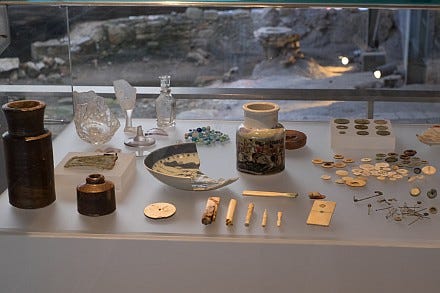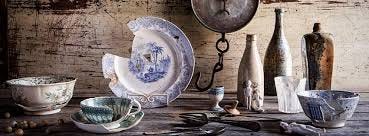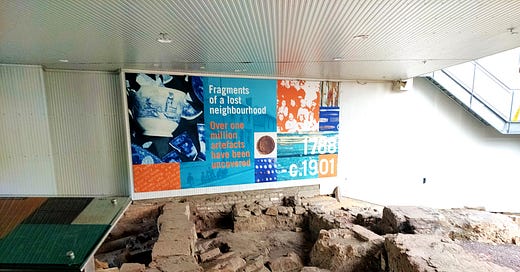I was recently in Sydney, Australia and I stayed in a hostel built around an archaeological dig site, aptly named The Big Dig. Wow! Layers of excavation uncovered millions of artefacts, going back to the beginnings of the colony in 1788, when the First Fleet of European settlers arrived in the land.
The Rocks, as this area of Sydney is known, has been through many transformations over the years. The dig revealed evidence of over 30 dwellings: homes, hotels, a bakery and a slaughter yard run by a local butcher who also ran an illegal still.


In the early 1900s the site became warehouses for the bustling dockyard, with concrete footings still visible. Later the site was used as a bus depot, then a car park, and now a hostel. So many stories have been pieced together from the fragments and layers. Stories of convicts and wharfies, families and merchants. And, of course, there’s an even deeper layer of life that could (must) be told, that of the Gadigal people who made the area home for tens of thousands of years before European settlement.
In the 1970s there was a battle to save the entire neighbourhood of The Rocks from proposed demolition for high rise buildings. Today, it is a preserved time capsule, nestled beneath Sydney Harbour Bridge, with vibrant cafes, shops and galleries. But the history remains: cobblestone roads, narrow alleys, and stone stairways. You can see colonial buildings, Australia’s oldest pubs and even a doss house.
It set me wondering…
This was all fascinating, but it got me thinking. I imagined someone in the future digging up evidence of my life. What would they discover? Would my ‘stuff’ give an accurate picture of my true passions, of the things that matter to my heart and soul? Probably not. How about you? What would an archaeologist make of your random stuff?
This is another reason to write our lives. Why not share what matters through our own words, rather than leaving it to historians to puzzle out. Why not put the fragments of our lives together now, in ways that are meaningful to us. But before we write, we need to gather the scattered material of our lives, so that we might accurately piece together our stories.
If you’re serious about transforming your life through writing, then it’s time to begin your own Big Dig, an excavation through the layers of your life in search of fragments, facets and fractals. Don’t worry about the differences yet. I’ll explain that soon. But, first we dig.
Layers?
It might be helpful to define your layers first. Your layers could be decades, or half-decades. Or your layers could be periods of time defined by what was happening in your life: places you lived, jobs you had, relationships. Define the layers in a way that makes sense to you. Then move, one period (layer) at a time. Let your mind drift back to that period and see what memories bubble up as significant. Look for anything with a glint to it, anything with a hint of story possibility, or transformation potential. Capture these ‘fragments’ in your journal. Later, you might explore photos to prompt your memories, but begin by seeing what your mind, heart and subconscious offer up.
Don’t overanalyse as you go. Sorting will come later. Then you will find connections and put puzzle pieces together. For now, just gather the bits.
So what is a fragment? ‘My primary (elementary) school years’ is a layer, not a fragment. ‘Shyness during my primary school years’ is closer, but better still would be this: ‘leaning against the fence on the edge of the playground, longing to join in with the girls skipping rope, but having no idea how to approach the group, and too afraid to try.’ That’s it. A fragment. Later it might join with other fragments around a theme of shyness (or not), but for now it stands alone.
What bubbles up next from those years?
Fragment 2: Sitting cross-legged on a mat as my grade one teacher reads aloud from “The Magic Faraway Tree,” by Enid Blyton. I’m enchanted by brownies and fairies, and by moss that’s like a green velvet cushion. I’m excited to discover what land will be at the top of the tree today, eager to know if it’s a good land, a bad land, or just a crazy land, and to find out if the children will get trapped there. I feel as if I’m with the children as they climb that tree. I can feel the tingle of Silky’s pop biscuits exploding on my tongue, and the thrill of riding down the tree slide on a colourful cushion.
Fragment 3: Leaves crunch beneath my feet as I walk to school (though sometimes the leaves are wet and slippery). As I turn the final corner, I’m confronted by the ‘cane chair dog’, as I call him, an Afghan hound who has me terrorised with his size and bark. My body tightens as I try to sneak past without him bounding at me, but I never get away with it. I am not invisible to him.
Warning
Now I must issue a warning. This task could lead to sleep deprivation.
Once you start searching for fragments they may come thick and fast, and I don’t know about you, but for me this kind of flow turns up several notches as soon as I lie down for a night of needed rest. Then I face a dilemma. Do I turn on the light and jot down the ideas that are flowing, or risk them disappearing into nothingness by morning? I write them down (of course). Close my notebook. Switch off the light. Shut my eyes. And there’s another one. Another pesky, beautiful memory. Of course there is. That’s how it works. And this wicked dance can go on for hours (especially if I have work the next morning). Please let me know in the comments if you relate.
Your Big Dig will take time. Time and patience. Many sessions. Why? Because there are layers, and so many bits and pieces to remember. Layers of discovery, layers of healing, layers of story. Don’t rush it though. The rewards are worth every dusty moment. When we uncover enough layers we may even get back to our original selves, to our core essence. I hear you sighing. This sounds like a lot of work. But it doesn’t have to be done all at once. We can dig and write, then cycle back to dig some more. Plus, surprising memories and unexpected discoveries provide thrills along the way.
Once you feel you have enough fragments to work with, its time to start sorting.
How to Sort?
There can be many ways to sort your fragments. It reminds me of another primary school memory. Attribute blocks. They could be sorted by colour, or by shape, by size or by thickness; and joined together in different ways. Your life is an infinitely more complex set of attributes. So be as creative as you want in the sorting, but there are three things I find helpful to think about as I sort: fragments, facets and fractals. Let me explain.
Everything you’ve gathered is a fragment, but some of those fragments might reveal more. The first question to ask as you read through your fragments is this: Do any of these hint at facets of my true self, facets of who I am, hidden in the ordinary (and extraordinary) moments of my life? Are there any recurring themes? As we become more attuned to our inner workings, we begin to recognize the facets of our identity that are truly ours, as opposed to those imposed by societal expectations or external pressures.
In the same way that the facets of a crystal might be polished until they shine, your facets are to be celebrated and polished too. They might just hold the key to your future. Can you find story fragments that hint at your gifts, talents, or passions? Is there anything that points to a thread of destiny, or purpose?
For example, I believe the story of the Magic Faraway Tree shines a light on a facet of who I am. It shows my love for literature, wonder and magical realism. Until I conducted my Big Dig, I hadn’t recognised this evidence of my identity, there from a young age.
Just as a gemstone has multiple facets that reflect light differently, we might discover various facets of ourselves, leading to a more comprehensive view of our identity and an appreciation for the complexity and richness of our lives.
Fractals are self-repeating patterns that can repeat at different scales. As you dust off your fragments, do any patterns emerge? Are there reactions that show up over and over at different times? If these patterns are adding goodness to your life, then great. If not, then perhaps you need to tweak the code that keeps spinning out that pattern. As you recognise repeating patterns, you can make informed decisions and break free from negative cycles. There’s healing potential here, and you can explore it on the page.
As an example, the fragment about me not joining in with the girls skipping was part of a pattern that repeated across the layers of my life. The pattern was this: letting my introversion hold me back from connection, and letting it stop me from going after the things I want. Notice, the pattern is not the introversion itself. I think that is something to celebrate, with the potential for deep connection even. The fractal that I want to recode is the pattern of letting introversion hold me back from life. I didn’t understand this until I wrote about it.
With fractals, a tiny change in the initial conditions can lead to vastly different outcomes. The same is true of tiny habit tweaks, or mindset changes.
Remember, when looking for fractals, the details are probably going to be different at each iteration of the pattern. For example, my playground example may show up later as holding back from applying for a job, despite being qualified. Later again, it might see me saying no to a travel opportunity with strangers. Same pattern, different situations.
Finally, the fragments that aren’t facets, or fractals, might just be random pieces of life that are nevertheless part of your journey. Some of these simply need to be remembered for what they were. Others might benefit from being reimagined. Or, they might require transformation and healing. This is where I love the image of repairing broken pottery with gold (the Japanese art of Kintsugi). Can any of your fragments be joined together to tell a story? Could they tell a brighter story than the one you’ve been telling your whole life? (More about this in another post.) Or might your fragments simply be juxtaposed to create a beautiful mosaic of your inner life?
Let’s Do It
Below are some lab sheets to record your findings and insights as you conduct a Big Dig through the layers of your life. Enjoy!
As always, remember self-care. Take breaks when you need them. Reward yourself as you deal with difficult areas, and talk to a therapist, or friend, if the digging gets too heavy.
Once your life has given up its secrets, once you have uncovered fragments and pieced together the puzzle clues of who you are, why you hurt, and what brings you joy, your world will begin to shift.
Some discoveries are going to be a delight, some will be a total surprise, some might be a relief, some I’m sure will be challenging, but all are going to be clues to what has been, what could be and what is right now.
Beth Kempton, Excavate Your LifeWhile archaeology helps preserve cultural heritage, writing preserves your personal narrative for yourself and others. As you conduct your Big Dig, you might want to share your discoveries with others through written stories. If so, I’d love you to pop links in the comments. Or perhaps you could simply share a favourite fragment.
Much love,









Really interesting approach to reviewing the unfolding of our lives, Phoebe. I love the concept of fragments, facets and fractals, and can recognise how I’ve used it, unknowingly, in my writing. Thank you for this fresh perspective.